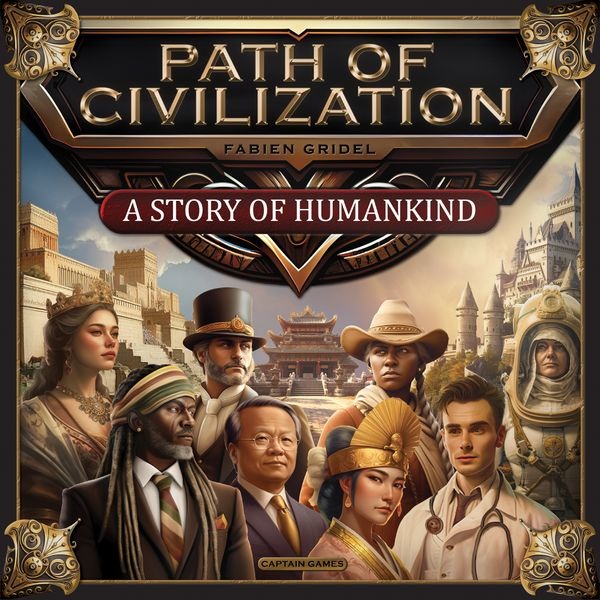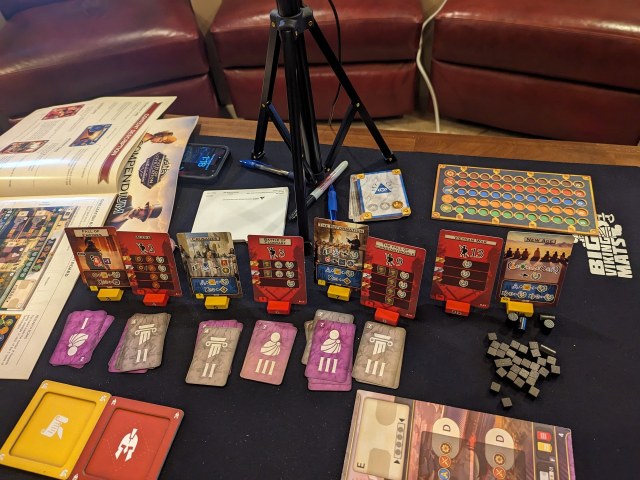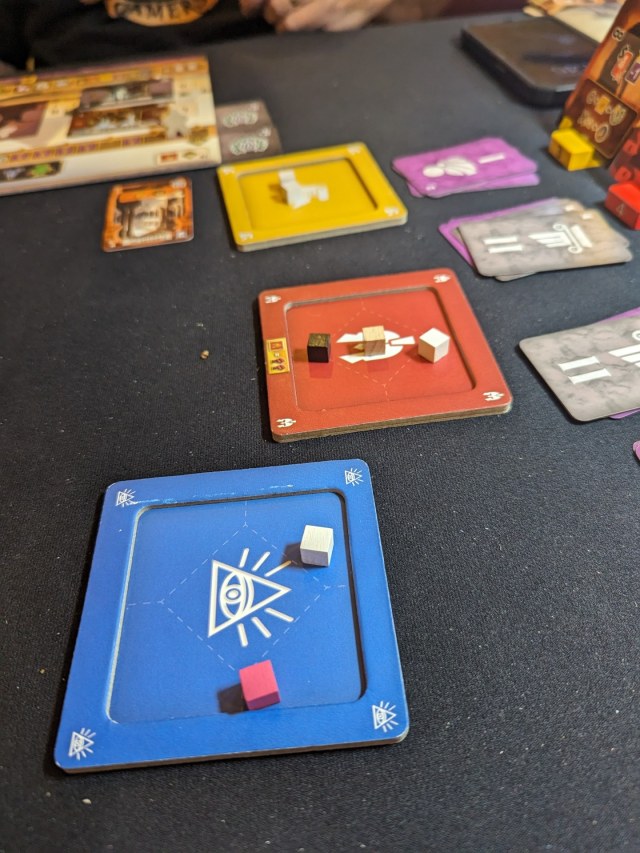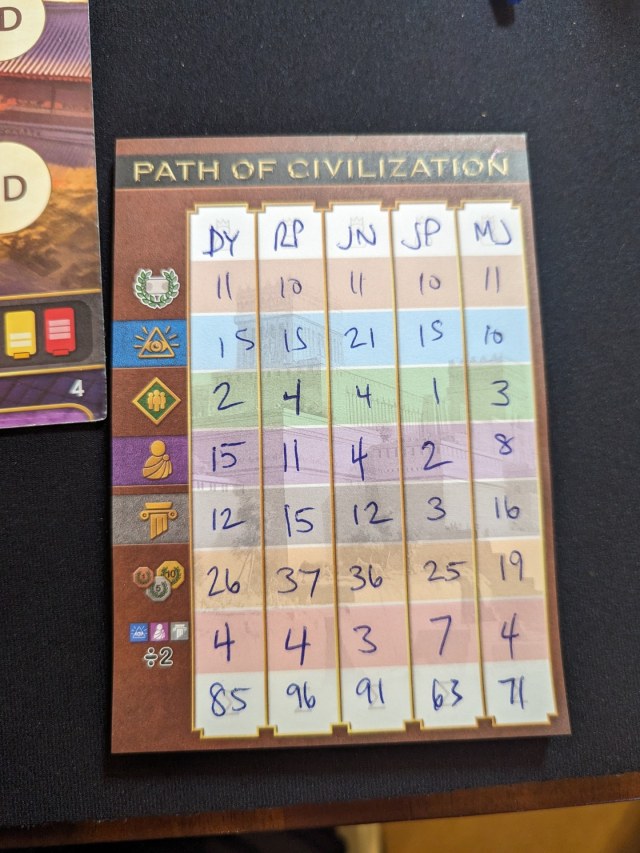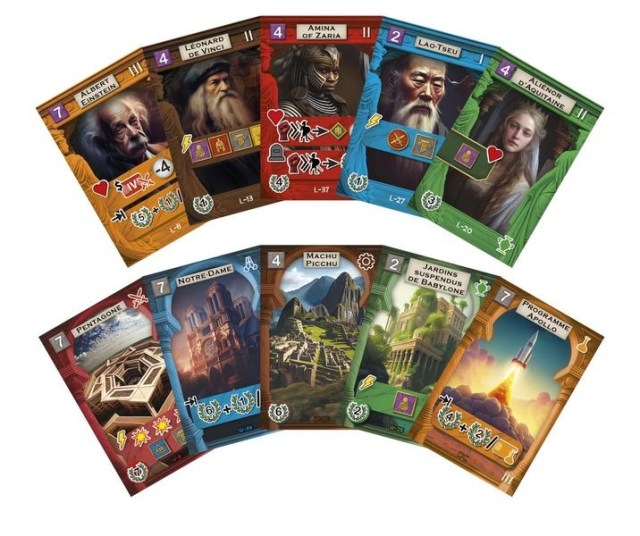Path of Civilization
- Designer: Fabien Gridel
- Publisher: Captain Games
- Players: 1-5
- Age: 14+
- Time: 20 min/player
- Played with review copy provided by publisher
Take the reins of your Civilization and make the choices that will make it the most prosperous. It doesn’t matter which path you take, as long as it leads your people to glory. Research new technologies to improve your nation’s Science, Military strength, Spirituality, Culture and Industrialization. Grow the greatest Philosophical current of humanity. Use your Philosophers to become one of its forerunners and thus decide its evolution. Send your Builders to create wonders from your territory that will outlive everything, even men. Grow your Population so that the most illustrious Leaders are born from it and change the world forever, even after their death. Develop your Military Legacy so that the name of your civilization is enough to make your opponents tremble. And if that is not enough, send your army to defeat even the most distant External Threat. Use your Sages and the knowledge of your civilization to solve the great Challenges of humanity that will mark its history.
In Path of Civilization, from the very first second of the game you must make choices that will have repercussions until the end of the game. The game is played simultaneously and works with a simple card and resource management system. The diversity of its cards guarantees enormous variability.
To set up the game, first find a sizable table to hold everything! The ten card stands (numbered 1 thru 8, 9a, 9b) are set up in a row, with yellow challenge cards going in the yellow stands and red battle cards going in the red stands. A market card and a round reminder card go in grey stands 1 and 2. The five technology libraries are placed on the table, with four levels of cards in green (cultural), yellow (scientific), blue(spiritual), red (military), brown (industrial). The military board is also placed on the table. Save area for a Leaders market and a Wonders market. Leader and Wonder cards will be dealt out near the card stands following the chart on the setup card. Each has its own tray which can be used to help designate the area. Finally, place the Philosophy board and its tray on the table as well with benefit tokens placed on the 10 spaces for them. Each player places a pawn at the start of the Military track on the common board as well as at the start of the Philosophy track on that common board.
Each player gets their own Civilization board, a research board, a starting hand of 5 cards and all the bits in their color. Players get 30 cubes, and the function of the cubes depends on which tray they are located in. Pawns start at the bottom of the 5 research tracks and the start of the population track. In the upper left of each Civ board is a unique starting bonus; each player should take this to start the game. There are four technology spaces in the center of the player board, a space for your current leader card in dead center, and a helpful iconographic player aid running along the bottom.
OK, the game is played in 9 rounds, each split up into 6 phases – each phase resolves simultaneously for the players. Have the most points at the end to be named “Leader of the most glorious Civilization of Humanity ”. The strip at the bottom of each player board will remind you of the steps.
(Setup) – before the phases start, advance the round marker, place any Leader or Wonder cards that come into the game now into their respective market, players take back their technology cards, and update the External Power on the battle board if necessary.
A] Project Phase – Each player takes their hand of 5 Technology cards and chooses 4 of them to play on their board; the 2 placed on the left will generate cubes in their respective trays and the 2 placed on the right will produce research points, tracked on the research board. The card which is not selected is placed facedown under the upper left corner of the board, and it will have a VP score on the back.
B] Deployment Phase – looking at the areas on cards on your board next to the big letter Bs, place one cube per icon shown on those areas into the respective trays. You are limited to a total number of cubes placed equal to your current population. If you generate more, you can choose which ones you choose to make and which ones you forfeit.
C] Evolution and Purchase – First, all players who have enough Philosophy cubes to advance must do so. If a new level for the game is achieved – new benefit tokens are revealed. Both are revealed if 2+ players make the new level, if only 1 player reaches a new level, they look at both and place one face up. Each time a player reaches a new Philosophy level, they get one of the bonuses shown, taken as many times as the multiplier in that column says to do it. Then players can acquire Wonders using their Builders. If there is a tie, players refer to their tiebreaker bar at the top of their board to see who has the card type in better position. Players then can spend Ambassador cubes to buy a Leader, ties again being broken by the priority bar. Leaders are placed in the center of the player board; you can only have one at a time, if you already have one, take your current one and place it facedown under the bottom of your board. Any cubes spent this phase are removed from the trays and placed back in the player’s supply.
D] Research Phase – looking at the areas on cards on your board next to the big letter Ds, advance the appropriate research cylinder per icon shown on those areas. You are limited to a total number of advancement equal to your current population. If you generate more, you can choose which ones you choose to advance and which ones you forfeit.
E] Technology Purchase – Each player must buy a new Technology card, the cost found in the upper left corner of the card. Payment is made in research points of matching type from your research board. Each card comes with a benefit that triggers when you buy it; the benefit is found on the stickers that line the box compartment where you got the card.
F] End of Round event – In rounds 3,5,7,9 there is a Yellow Challenge. In rounds 4,6,8,9, there is a Red Battle. (There are no events in the first two rounds). Each type is resolved differently.
Challenges – there are two boxes on these cards. The top box is the Destiny box, and this applies to all players, and it can be resolved multiple times if a player meets the prerequisite multiple times. The bottom is the History box which each player has to individually score; this box will convert into points as well as possibly cubes being placed into trays.
Battles – The card shows an external strength for the outside civilization at the top and then a set of rewards based on a player’s relative ranking in Power. Power is equal to your current standing on the battle track plus 2 times the number of cubes in the Military tray. Rank all the players and the civilization on the card; and then allocate bonuses. The card does not collect anything but it can take up a spot to deny a player a bonus. All military cubes are removed from the tray and placed back in the player’s supply.
This pattern is repeated through all 9 turns, and then the final score is calculated:
- VP on Technology cards, both active and discarded
- VP for position on the Philosophy track
- VP for position on the population track on the player board
- VP for all Leader cards
- VP for Wonder cards as well as any end game bonuses on them
- VP tokens collected during the game
- VP for unused cubes in trays – 1 pt for every 2 cubes left
The player with the most points wins. There is no tiebreaker.
My thoughts on the game
This was one of the games that I’ve been looking forward to since I learned about it. I am a sucker for these “civilization building” games, and this one was sold as a quick and elegant one. There are only 9 rounds in the game, and frankly, there isn’t much to each round! Play cards, get things/place cubes, move up the tracks, buy a new card, repeat. And, with the play happening simultaneously – the game really does fly by.
Rules – well, at first I didn’t know what to think when I opened the box; I mean, I was kind of overwhelmed by the documentation. You get two thick books of rules as well as a foldout solo game pamphlet. As it turns out, the rules are just verbose; and I mean this in a good way. There are plenty of explanations and numbered illustrated examples in the rules – for instance, the actual game flow doesn’t even start until page 10 of the rulebook! And, I mentioned that there are two “books” – the other is a reference for many of the cards in the game; and let me tell you, I’m super appreciative to have a printed reference for these cards instead of nothing at all or a QR code sending me to try to read small text on my phone. Though there were a lot of words to read, it was well organized, and I’m not complaining about the extra pictures/words…
And like I said at the top, once you learn the flow, the game is actually pretty intuitive and each phase plays quickly. We’re definitely hitting the 20min/player suggestion on the box now, and the game is engaging throughout the entire length.
The card system is really neat, and I love the fact that your hand is in constant flux. You lose 20 percent of your hand each turn, and you really have to think hard about which card icons you’re willing to give up – because once you discard it, it’s gone! In most of my games, I’ve had to face an agonizing decision where I had to discard a more powerful card because I really needed a specific icon on a different card – oftentimes to meet the needs of the event card for the round… There are also plenty of times when you want to use the same card for cubes and track bumps, but you have to choose which way to go…
The tiebreaker system is also a nice and elegant way to resolve the events, and it just takes a bit of communication to ask who holds which tiebreaker. If I think about it, I was going to mock up my own player aid that put the five tiebreaker bars on a single card so that each player could have their own reference and know ahead of time what the tiebreaker order is for each player.
Bits – The card holders are great for both storage and gameplay. It is really nice for everyone to be able to easily grab the card they need, and the stickers reminding people of the bonuses are easy to see. As play is simultaneous, there is a lot of action going on with cubes and cards being placed/picked up all over. You’ll want to have a large table as there are a lot of things you need to have laid out; but at the same point, you’ll likely need to be able to reach everything. Our table is a bit on the large side, so we ended up having to pass cubes to players near certain things, telling them where to place them, etc. The only thing that isn’t super ergonomic are the round cards. We really haven’t found a place to put them where everyone can see them easily; but that could just be a table issue or the fact that we almost always play with five, and there are just so many things on the table at that point.
We’ve seen many different strategies win the game, and there is a lot of latitude to decide what direction(s) you want to go in the game. As you buy cards, you’ll get stronger in certain areas, and you have to decide whether to focus on a single area (I got my clock cleaned by someone in the last game who went Philosophy all the time) or to branch out to give yourself multiple strong areas.
The game has met my pre-Spiel expectations, and I have enjoyed playing it. The turns are quick, yet there are a lot of decisions to be made each round. It also has a solo version which I have not yet tried, but I’ve heard many good things about it as well. Path of Civilization is making its way onto the permanent shelving in the game collection.
Thoughts from other Opinionated Gamers
Mark Jackson (2 plays – one of those solo): Another civilization building game – with an intriguing mechanic where you continually are getting rid of earlier “technology” cards in order to progress forward. It worked very well both with 4 players and as a solo game. The first time we set up the game was a lot of work – but once you’ve done the work of putting things together in a logical manner, it’s pretty easy to do. The rulebook felt heavier than the rules actually are – the game itself is very straightforward (and interesting) after you’ve learned it. There is a lot of variety in the various challenge and battle cards, as well as the various leaders and wonders that appear. The solo system – while very easy to run – seemed a little weak… but I was playing on the easy setting.
Larry (1 play): Like Dale, I love Civ games, so I was inclined to like this and I did. The game plays very smoothly, because much of the action is simultaneous. Assigning your cards is interesting and can lead to agonizing choices. There’s a reasonable amount of indirect player interaction, but no direct attacks, as you’d expect from a Euro. Thematically, this has a Civ feel, with appropriately named leaders and wonders, but it’s still fairly abstract, so base your expectations on that. My game had five players and it didn’t drag at all, which is a real plus, as good 5-player games are so hard to find these days. Overall, Path of Civilization delivers a game of nice scope in a relatively short timeframe and it looks as if there will be a good deal of replayability, because of all of the options included in the base game.
Ted C. (1 play): I quite enjoyed my one play of the game. Reminded me of Hadara/Seven Wonders. Would gladly play again.
Dan B. (2 plays): So far I like it, and definitely would like to play more. As noted, once everyone knows the rules it plays quickly, and it has a fair number of interesting decisions. I do wonder a bit about staying power – obviously the random challenges, battles, leaders, and monuments will provide a fair amount of variance, but the fact that the technology cards are always the same means that the core of the game never changes. We’ll have to see if people still want to play after it’s no longer the new hotness.
Ben B. (1 play): We like this one as it has simple turns and plays 5p in just 90 minutes, maybe even faster if we weren’t teaching. Setup does take a moment though. I think its just good, not great, because it would need more variability between games for me.
Ratings from the Opinionated Gamers
- I love it! Dale, Mark Jackson, Steph H
- I like it. John P, Larry, Craig M. Ted C., Dan B., Ben B.
- Neutral.
- Not for me…

